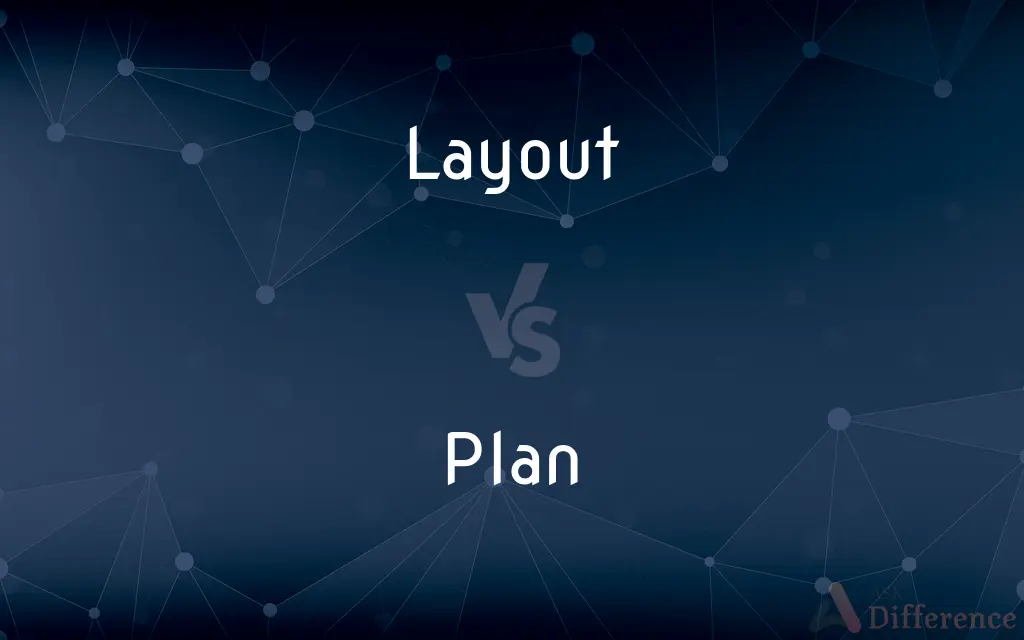Layout vs. Plan — What's the Difference?
By Tayyaba Rehman & Urooj Arif — Updated on April 2, 2024
A layout details the arrangement and organization of elements within a space, focusing on design and functionality, while a plan outlines steps or strategies for achieving specific goals, emphasizing sequence and process.

Difference Between Layout and Plan
Table of Contents
ADVERTISEMENT
Key Differences
A layout typically refers to the spatial arrangement of physical elements, such as furniture in a room or components on a webpage. It focuses on aesthetics, functionality, and the efficient use of space, ensuring that each element is placed for optimal performance and appeal. On the other hand, a plan is a detailed proposal or strategy for achieving a particular goal or set of goals. It emphasizes the sequence of actions, resource allocation, and time management, outlining how objectives will be met.
Layouts are crucial in design and architecture, where the physical and visual aspects of spaces need to be harmonized. Designers consider the user's experience, accessibility, and interaction between space elements. Plans, however, are essential in project management, construction, and any strategic endeavor, where they serve as blueprints for achieving targets, specifying milestones, resources, and the path forward.
While a layout is more static, representing a snapshot of an arrangement at a particular moment, a plan is dynamic and can evolve over time based on progress, challenges, and changing objectives. Plans may undergo revisions and updates, reflecting a project's living document aspect. In contrast, once a layout is executed, it tends to remain unchanged unless significant redesign is required.
In the context of building or development projects, the layout is part of the planning process, focusing specifically on the spatial and functional organization within the project’s broader scope. Plans in such projects detail the timeline, budget, and phases of development, incorporating layouts as components of the overall strategy.
Despite their differences, both layouts and plans are fundamental to successful projects, whether in design, construction, business, or personal endeavors. A well-thought-out layout enhances the user experience and operational efficiency, while a comprehensive plan ensures goals are achievable, resources are well-utilized, and timelines are met.
ADVERTISEMENT
Comparison Chart
Focus
Spatial arrangement and design of elements
Strategy and steps to achieve goals
Application
Design, architecture, websites
Project management, business strategies
Emphasis
Aesthetics, functionality, space usage
Sequence of actions, resource allocation
Nature
Static, visual representation
Dynamic, can evolve over time
Role in Projects
Part of the planning, focuses on organization
Blueprint for achieving project objectives
Compare with Definitions
Layout
Organization of text and images on a page.
The magazine's layout made the articles easy to read and visually appealing.
Plan
Sequence of steps to be taken.
The lesson plan detailed the topics and activities for each class session.
Layout
The arrangement of elements within a space.
The office layout was designed for maximum productivity and comfort.
Plan
Allocation of resources for a project.
The construction plan specified materials, labor, and equipment needs.
Layout
A plan of how objects are positioned.
The website's layout was intuitive, enhancing user navigation.
Plan
A detailed proposal for achieving objectives.
The project plan outlined every phase, from initiation to closure.
Layout
Configuration of equipment or facilities.
The factory layout was revised to streamline the production process.
Plan
Strategy for accomplishing a goal.
Their business plan was comprehensive, covering marketing, operations, and finance.
Layout
Design of circuits on a PCB.
The electrical engineer optimized the circuit layout to reduce noise.
Plan
Schedule of activities or events.
The event plan included timelines for setup, performances, and teardown.
Layout
The way in which the parts of something are arranged or laid out
The road layout
Plan
A plan is typically any diagram or list of steps with details of timing and resources, used to achieve an objective to do something. It is commonly understood as a temporal set of intended actions through which one expects to achieve a goal.
Layout
The act or an instance of laying out.
Plan
An orderly or step-by-step conception or proposal for accomplishing an objective
A plan for improving math instruction.
Layout
An arrangement or plan, especially the schematic arrangement of parts or areas
The layout of a factory.
The layout of a printed circuit.
Plan
A proposed or intended course of action
Had no plans for the evening.
Layout
The art or process of arranging printed or graphic matter on a page.
Plan
A systematic arrangement of elements or important parts; a configuration or outline
A seating plan.
The plan of a story.
Layout
The overall design of a page, spread, or book, including elements such as page and type size, typeface, and the arrangement of titles and page numbers.
Plan
A drawing or diagram made to scale showing the structure or arrangement of something.
Layout
A page or set of pages marked to indicate this design.
Plan
In perspective rendering, one of several imaginary planes perpendicular to the line of vision between the viewer and the object being depicted.
Layout
(Sports) The straight position, as in diving.
Plan
A program or policy stipulating a service or benefit
A pension plan.
Layout
(Informal) An establishment or property, especially a large residence or estate
"[Her] show horses ... were kept on the couple's one-and-a-half acre Malibu layout" (People).
Plan
To formulate a scheme or program for the accomplishment, enactment, or attainment of
Plan a campaign.
Layout
A structured arrangement of items within certain limits.
Plan
To have as a specific aim or purpose; intend
They plan to buy a house.
Layout
A plan for such arrangement.
Plan
To draw or make a graphic representation of.
Layout
The act of laying out something.
Plan
To make plans.
Layout
(publishing) The process of arranging editorial content, advertising, graphics and other information to fit within certain constraints.
Plan
A drawing showing technical details of a building, machine, etc., with unwanted details omitted, and often using symbols rather than detailed drawing to represent doors, valves, etc.
The plans for many important buildings were once publicly available.
Layout
(engineering) A map or a drawing of a construction site showing the position of roads, buildings or other constructions.
Plan
A set of intended actions, usually mutually related, through which one expects to achieve a goal.
He didn't really have a plan; he had a goal and a habit of control.
Layout
(electronics) A specification of an integrated circuit showing the position of the physical components that will implement the schematic in silicon.
Plan
A two-dimensional drawing of a building as seen from above with obscuring or irrelevant details such as roof removed, or of a floor of a building, revealing the internal layout; as distinct from the elevation.
Seen in plan, the building had numerous passageways not apparent to visitors.
Layout
A plan or design of something that is laid out
Plan
A method; a way of procedure; a custom.
Layout
The act of laying out (as by making plans for something)
Plan
A subscription to a service.
A phone plan
An Internet plan
Plan
(transitive) To design (a building, machine, etc.).
The architect planned the building for the client.
Plan
(transitive) To create a plan for.
They jointly planned the project in phases, with good detail for the first month.
Plan
(intransitive) To intend.
He planned to go, but work intervened.
Plan
(intransitive) To make a plan.
They planned for the worst, bringing lots of emergency supplies.
Plan
A draught or form; properly, a representation drawn on a plane, as a map or a chart; especially, a top view, as of a machine, or the representation or delineation of a horizontal section of anything, as of a building; a graphic representation; a diagram.
Plan
A scheme devised; a method of action or procedure expressed or described in language; a project; as, the plan of a constitution; the plan of an expedition.
God's plans like lines pure and white unfold.
Plan
A method; a way of procedure; a custom.
The simple plan,That they should take who have the power,And they should keep who can.
Plan
To form a delineation of; to draught; to represent, as by a diagram.
Plan
To scheme; to devise; to contrive; to form in design; as, to plan the conquest of a country.
Even in penance, planning sins anew.
Plan
A series of steps to be carried out or goals to be accomplished;
They drew up a six-step plan
They discussed plans for a new bond issue
Plan
An arrangement scheme;
The awkward design of the keyboard made operation difficult
It was an excellent design for living
A plan for seating guests
Plan
Scale drawing of a structure;
The plans for City Hall were on file
Plan
Have the will and intention to carry out some action;
He plans to be in graduate school next year
The rebels had planned turmoil and confusion
Plan
Make plans for something;
He is planning a trip with his family
Plan
Make or work out a plan for; devise;
They contrived to murder their boss
Design a new sales strategy
Plan an attack
Plan
Make a design of; plan out in systematic, often graphic form;
Design a better mousetrap
Plan the new wing of the museum
Common Curiosities
What is the primary purpose of a layout?
The primary purpose of a layout is to organize space efficiently and aesthetically, focusing on the arrangement of elements within a given area.
How does a plan differ from a layout in construction?
In construction, a plan outlines the project's steps, timelines, and resources, while a layout focuses on the spatial arrangement of structural elements.
What role do layouts play in user experience?
Layouts play a critical role in user experience by determining how easily and pleasantly users can interact with a space or interface.
How are plans used in business strategy?
Plans in business strategy are used to outline goals, tactics, resource allocation, and timelines, guiding the organization towards its objectives.
Why is a layout important in website design?
A layout is crucial in website design for ensuring user-friendly navigation, visual appeal, and effective communication of information.
Is a layout fixed once implemented?
While layouts tend to be relatively static once implemented, they may be revised or redesigned based on feedback, evolving needs, or improvements in design practices.
How do constraints affect layouts and plans?
Constraints such as budget, space, and regulations can significantly influence the design of layouts and the feasibility of plans, requiring adjustments and optimizations.
How often should plans be reviewed and updated?
Plans should be reviewed and updated regularly to reflect progress, address challenges, and adapt to any changes in objectives or conditions.
Can a plan include multiple layouts?
Yes, a comprehensive plan can include multiple layouts, such as floor plans, site layouts, and equipment layouts, each detailing a specific aspect of the project.
Can a plan be successful without considering layouts?
For projects involving physical spaces or design elements, considering layouts is essential for the plan's success, as it affects functionality and user experience.
What tools are used to create layouts and plans?
Various tools can be used, including CAD software for layouts and project management software for plans, to facilitate precision and collaboration.
What is the importance of flexibility in plans?
Flexibility in plans allows for adjustments in response to unforeseen challenges or opportunities, ensuring the project's resilience and success.
How does technology impact the development of layouts and plans?
Technology offers advanced tools for creating more accurate and detailed layouts and plans, enabling better visualization, simulation, and optimization.
What considerations are crucial when transitioning from planning to layout design?
Considerations include aligning the layout with the plan's objectives, ensuring practicality and compliance with regulations, and focusing on the end-user's needs and experiences.
Can layouts affect the success of a plan?
Yes, the effectiveness of a layout can directly impact the success of a plan, especially in terms of operational efficiency, cost savings, and user satisfaction.
Share Your Discovery

Previous Comparison
Him vs. Himself
Next Comparison
Terrace vs. BalconyAuthor Spotlight
Written by
Tayyaba RehmanTayyaba Rehman is a distinguished writer, currently serving as a primary contributor to askdifference.com. As a researcher in semantics and etymology, Tayyaba's passion for the complexity of languages and their distinctions has found a perfect home on the platform. Tayyaba delves into the intricacies of language, distinguishing between commonly confused words and phrases, thereby providing clarity for readers worldwide.
Co-written by
Urooj ArifUrooj is a skilled content writer at Ask Difference, known for her exceptional ability to simplify complex topics into engaging and informative content. With a passion for research and a flair for clear, concise writing, she consistently delivers articles that resonate with our diverse audience.














































